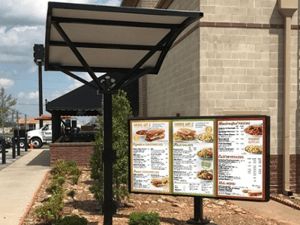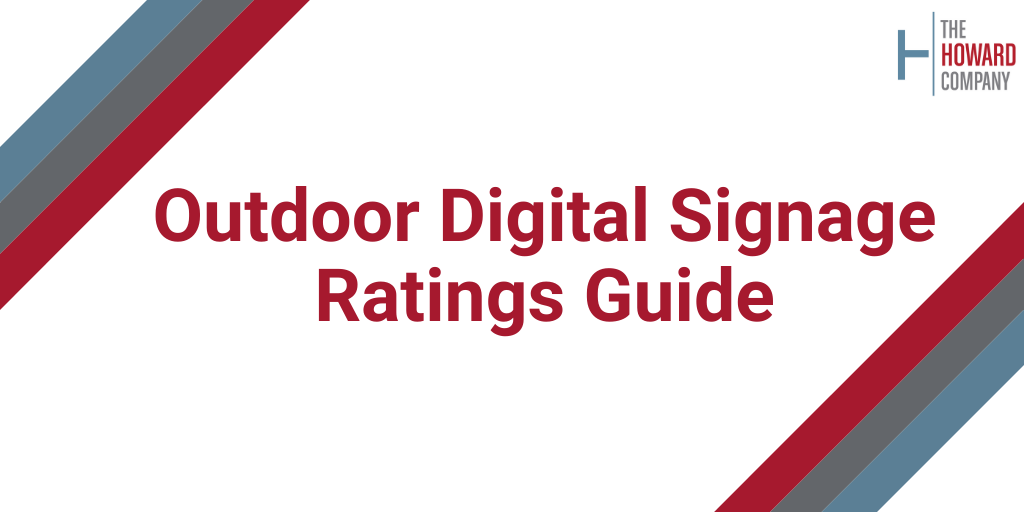Investing in digital signage is a great tactic to upgrade the method you communicate with your customers, and it is important to think of it that way - as an investment. When considering electronic displays for outdoor applications - like digital drive-thrus - you must understand the unique features that will protect the asset and generate a better return.
There are five critical specs and features of commercial-grade, outdoor-rated, digital  displays that distinguish them from other commercial screens and televisions. By understanding these specs, buyers can be more informed when choosing between competing models, and confident that the investment is necessary.
displays that distinguish them from other commercial screens and televisions. By understanding these specs, buyers can be more informed when choosing between competing models, and confident that the investment is necessary.
The most notable features of an outdoor display should be obvious. It needs to survive outdoor installation, and exposure to the elements, including precipitation, dirt, direct sunlight, and extreme temperatures. Well-designed outdoor displays have the features described below.
Feature #1 - IP Rating (How does the device handle moisture and dirt?)
Outdoor-rated devices should have an IP Rating. The IP (Ingress Protection) Code consists of the letters 'IP' followed by two digits. It classifies the amount of protection from the intrusion of solid objects (including fingers), dust, accidental contact, and water in electrical enclosures. This standard aims to provide a more detailed measurement of expected protection instead of vague marketing terms such as "waterproof."
The digits indicate conformity with conditions summarized by standardized tables. The first digit shows how well it is protected against solid objects, and the second shows protection of the equipment against harmful ingress of water.
Here are a couple of examples of the IP Code number and their meanings. A figure from each column combines for the rating.
| IP Rating |
|
| First Digit | Second Digit |
| Solids Protection Scale of 0-6, 6 being the best | Liquids Protection Scale of 0-8, 8 being the best |
| 2 = >12.5 mm (objects the size of fingers cannot get inside) | 2 = Dripping Water (vertically dripping water or up to 15 ° will not cause harm) |
| 4 = >1 mm (most wires, screws, etc.) | 4 = Splashing Water (water splashing against the device from any direction will have no effect) |
| 5 = Dust Protected (will not interfere with the satisfactory operation) | 6 = Powerful Water Jet (water from a pressure washer, 12.5 mm nozzle, shall have no harmful effect) |
| 6 = Dust Tight (complete protection) | 8 = Immersion beyond 1m (suitable for continuous immersion in water – hermetically sealed) |
Zeros mean there would be no protection at all, and IP22 means it is safe from the insertion of fingers and vertically or nearly vertically dripping water. To withstand Mother Nature, however, outdoor displays have ratings typically of IP56 or higher. The highest rating is IP68, which is dust-tight and water-tight. Bring on the fog and sideways blowing rain!
Feature #2 – NITs (Screen Brightness)
It can be a challenge to see a clear image on a display in direct sunlight. Even ambient light on a bright day can make seeing content on the screen difficult. The brighter the screen, the better it competes with other sources of light. Digital displays brightness is measured in NITs, a unit of visible light intensity. A consumer display (home TV) is usually around 200-300 NITs, but electronic menu displays rated for indoor commercial applications are generally 400-500 NITs. Outdoor digital screens, like those in drive-thru digital menus, are 2500 NITs or brighter. That’s almost a whole order of magnitude difference. After all, they are competing directly with the sun.
Feature #3 – Operating Temperature Range
Outdoor commercial displays are built to handle temperature extremes. An example of one manufacturer's published operating ranges for cold and heat is from -31.0 °F to 140.0 °F. Manufacturers use a variety of different technologies, including cooling fans and large aluminum heat sinks to dissipate heat and to operate in these ranges. These various solutions to handling high heat can impact both energy usage and a display’s IP Rating. A unit with an exhaust fan will have a slightly lower IP Rating because it cannot be fully submerged in water. It will not be able to achieve a liquid score of eight.
Feature #4 – Power Consumption (Wattage)
Despite the energy efficiencies of LED backlight technology, driving enough LEDs and at the intensities to achieve the super high-bright output of 2,500+ NITs uses a lot of power. A typical 55”, 500 NIT commercial indoor screen may consume 55 watts/hr, whereas a 55”, 2,500 NIT high-bright outdoor screen can use from 186 to 510 watts/hr. With that broad range of power consumption, an evaluation of the total cost of ownership is crucial to make an informed decision. Given the two outdoor examples above, with similar operating temperature range support and equivalent brightness, the energy savings makes this an important specification. Look for features to power off displays when not in use and ambient light sensors to reduce the brightness levels after dusk can save on energy bills.
Feature #5 – Assembly Method (Optically Bonded vs. Air Gap)
Different technology is used to make outdoor displays easier to read. Many manufacturers add special coatings to the front of the display’s glass to reduce glare, be more scratch-resistant, and even to make the removal of some graffiti easier. These coatings are similar to those that are frequently added to prescription eyeglasses. The second innovative process cuts even more glare, allowing images to be crisper and clearer—optical bonding. In the assembly of the display panel, a layer of either silicone, urethane, or epoxy is laminated (sandwiched) between the display LCD matrix and the protective outer glass. This bonding creates a single refraction point, significantly reducing glare over screens that have an air gap between the LCD matrix and the glass. That gap creates multiple refraction points and, thus, more glare. Also, note that ambient light is not the only challenge. Light hits the screens from both directions – the LCD itself produced light. Finally, optical bonding eliminates the possibility of condensation or dust getting onto the inside surface of the protective glass.
Bonus Feature #6 – Screen Mechanical Impact (IKXX Rating)
The optical bonding process can increase the durability, measured as an IKXX Rating of the display. IKXX rating ranges from IK00 to IK10. The maximum of IK10 means protection from being hit by a solid object equivalent to 5 kg of steel being dropped 40 cm onto the face of a display. An optically bonded 55” outdoor display typically has an IK10 rating. There are also other ways to achieve IK10 without optical bonding, like using thicker/stronger glass, but the additional thickness can potentially increase glare.
Recommended Feature #7 – White-Glove Warranty
Although nobody likes to think about it, sometimes digital screens fail in the field and if that happens, it can be a challenge to swap out the bad screens. Without a white glove warranty, most of the work falls on you to disassemble, pack, and ship the displays only to wait for the replacements to arrive. This could could potentially lead to your business to go days or weeks without a screen, leaving an open spot where it should be placed. With white glove warranty, the manufacturer takes care of it all, including bringing a replacement screen, most likely within one business day. Although not required, it is an option most operators wisely chose when they purchase outdoor digital displays.
To sum up, when investing in high-bright outdoor-rated displays, an educated purchaser should consider each of the following:
1. How well will it withstand being exposed to water and dust (IP Rating)
2. What is the NIT rating for the display? Can you see it in the bright outdoors?
3. How will it disperse heat? Can it survive the cold of winter months?
4. What is the energy consumption? What are the impacts on the total cost of ownership?
5. How is the panel built, and what features will make content the most readable?
Finally, using a company that is experienced in installing digital drive-thrus is probably the most important decision you will make when investing in outdoor digital displays. Make sure to consult experts who can answer all of your questions and who can be trusted to help you find the right solution.
This blog was published July 2019. It has been revised as of February 2023.


